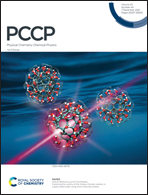The effect of charged defects on the stability of implanted helium and yttrium in cubic ZrO2: a first-principles study
Abstract
The effect of charged defects on the stability of implanted He and Y atoms has been fully investigated to gain insight into the occupation mechanism of defects in cubic ZrO2 using first-principles calculations. For the intrinsic point defects in ZrO2, the configurations of VO2+, IO2−, VZr4−, and IZr4+ are dominant, which have the lowest formation energy over the widest Fermi level range, respectively. He atoms at neutral Zr vacancies have the lowest incorporation energy (0.438 eV), illustrating that the VZr0 is probably the most stable trapping site for He atoms. For the Y atoms implanted in ZrO2, the most stable configuration of YZr1− is obtained over the widest Fermi level range. In the Y-doped ZrO2, the incorporation energy of He at the site of Oct2 interstitial is the lowest (1.058 eV). For He atoms trapped at vacancies, He-VZr0 has the lowest incorporation energy of 0.631 eV. These results indicate that He atoms preferentially occupy the sites of VZr0. The state of electric charge plays a significant role in the formation of defects in the ionic compound. The present simulation results provide a theoretical foundation for the effect of charged defects on the stability of He atoms, which contributes to the understanding of the microscopic solution behaviour of He atoms in perfect ZrO2 and Y-doped ZrO2.



 Please wait while we load your content...
Please wait while we load your content...